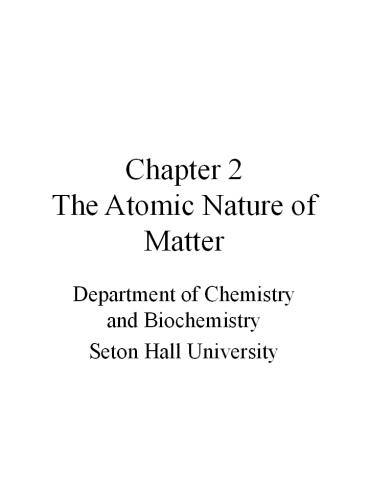Chapter 2 The Atomic Nature of Matter - PowerPoint PPT Presentation
Title:
Chapter 2 The Atomic Nature of Matter
Description:
Bulk of atomic theory was described by Dalton ... We can 'see' individual atoms via STM, and it confirms our expectations ... Diffusion - the passage of a particle ... – PowerPoint PPT presentation
Number of Views:198
Avg rating:3.0/5.0
Title: Chapter 2 The Atomic Nature of Matter
1
Chapter 2The Atomic Nature of Matter
- Department of Chemistry and Biochemistry
- Seton Hall University
2
Atomic Theory
- Bulk of atomic theory was described by Dalton
- Basic key is the definition of a compound
(anybody remember?) - We can see individual atoms via STM, and it
confirms our expectations (consider what if it
didnt?)
3
Daltons Theory
- All matter is composed of tiny particles called
atoms - All atoms of a given element have identical
chemical properties that are characteristic of
that element - Atoms form chemical compounds by combining in
whole-number ratios - Atoms can change how they are combined, but they
are neither created nor destroyed in chemical
reactions (the Law of the Conservation of Mass)
4
Several Related Points
- Matter and energy are interconverted, the amount
of mass involved is unmeasureable - Atoms and molecules are continually in motion
- Diffusion - the passage of a particle
- Dynamic equilibrium - balanced motion of
particles (consider evaporation, diffusion)
5
Atomic Architecture
- Matter is held together by forces
- gravitational
- electrical
- magnetic
- Atoms consist of
- nucleus - contains protons and neutrons
- electrons
6
Atomic Architecture
- Nucleus contains essentially all of the mass of
the atom, but essentially none of the volume - Electrons have virtually none of the mass, but
occupy basically all of the volume - An atom the size of a baseball stadium will have
a nucleus the size of a pea
7
Atomic Diversity
- An element is identified by the charge of its
nucleus (the number of protons) - Isotopes have the same number of protons, but
different number of neutrons - X - element symbol
- A - atomic mass (number of protons and neutrons)
- Z - atomic number (number of protons)
8
Isotopes
- Most elements occur naturally as two or more
isotopes, hence the fractional atomic mass - Isotopes of hydrogen
- protium - one proton, one electron
- deuterium - one proton, one neutron, one electron
- tritium - one proton, two neutrons, one electron
- Mass spectrometry - see fig 53 measures mass
very precisely
9
Charged species
- Charged chemical species are called ions
- cations - positively charged
- anions - negatively charged
- Ions can be atoms or molecules
- Compounds formed from two or more ions are called
ionic compounds or salts - Salts often dissolve in liquids to give separated
ions
10
Forms of energy
- Kinetic - E0.5mv2
- Potential
- Thermal
- Chemical
- Radiant
- Electrical
11
Conservation of Energy
- Energy is neither created nor destroyed in a
chemical process, but may be transferred from one
body to another or changed from one form to
another - End of Chapter 2































